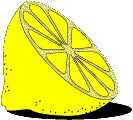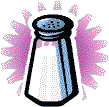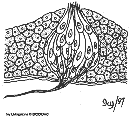 |
That's Tasty |  |
 |
That's Tasty |  |
 Delicious, scrumptious, delectable, mouth-watering,
yummy.
Delicious, scrumptious, delectable, mouth-watering,
yummy.Stale, awful, terrible, unsavory, bland, unpalatable. Just a few of the many words to describe how food tastes. Notice too, that these words can also describe smells. As you might imagine, smell and taste are often linked together. The sense of taste is also called gustation. |
|
For food to have a taste, it must be dissolved in water. There are four basic tastes: sweet, salty, sour and bitter: |
| SWEET | SOUR | SALTY | BITTER |
 |
 |
 |
 | Like a piece of cake | Like a lemon | Like, well, salt! | Like a cup of bad coffee |
| All other tastes
come from a combination of these four basic tastes. Actually, a fifth
basic taste called "Umami" has recently been discovered. Umami is a taste
that occurs when foods with glutamate (like MSG) are eaten. Different
parts of the tongue can detect all types of tastes. Morever, the simple
tongue "taste map" that is found in many textbooks has been criticized
for several reasons (also
here). The actual organ of taste is called the "taste bud." Each taste bud (and there approximately 10,000 taste buds in humans) is made up of many (between 50-150) receptor cells. Receptor cells live for only 1 to 2 weeks and then are replaced by new receptor cells. Each receptor in a taste bud responds best to one of the basic tastes. A receptor can respond to the other tastes, but it responds strongest to a particular taste. | The Taste
Bud Image from Biodidac |
| There are two cranial nerves that innervate the tongue and are used for taste: the facial nerve (cranial nerve VII) and the glossopharyngeal nerve (cranial nerve IX). The facial nerve innervates the anterior (front) two-thirds of the tongue and the glossopharyngeal nerve innervates that posterior (back) one-third part of the tongue. Another cranial nerve (the vagus nerve, X) carries taste information from the back part of the mouth. The cranial nerves carry taste information into the brain to a part of the brain stem called the nucleus of the solitary tract. From the nucleus of the solitary tract, taste information goes to the thalamus and then to the cerebral cortex. Like information for smell, taste information also goes to the limbic system (hypothalamus and amygdala). Another cranial nerve (the trigeminal nerve, V) also innervates the tongue, but is not used for taste. Rather, the trigeminal nerve carries information related to touch, pressure, temperature and pain. | Cranial
Nerves used for taste
|
Did you know? |
|

 Try some experiments to test your sense of taste. Try some experiments to test your sense of taste.
For more about the sense of taste, see: |

| GO TO: | Hearing | Smell | Taste | Touch | Vision | Working Together |
| BACK TO: | The Senses | Experiments and Activities | Table of Contents |
![[email]](./gif/menue.gif) Send E-mail |
 Get Newsletter |
 Search Pages |
 Donate to Neuroscience for Kids |